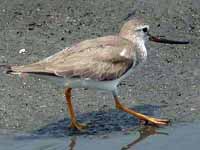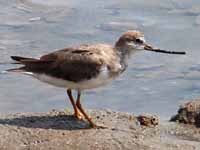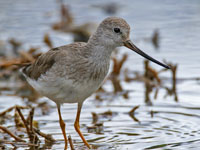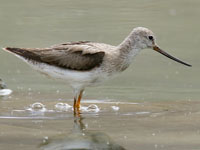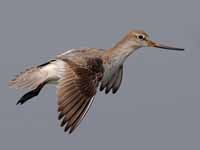THE WORLD BIRDS - An Online Bird Book
SHOREBIRDS
Large bill Sandpipers and Allies
Order Charadriiformes Family Scolopacidae
SHOREBIRDS
Most Shorebirds walk along shores probing for food with their thin sensitive bills. Bill length varies considerably so differing species can work the same shore and obtain different
food supplies. Shorebirds include sandpipers, godwits, stilts, oystercatchers, plovers, and many more. Shorebirds belong to the Charadriiformes order which also includes the Gulls
and Allies.
Note: the term Shorebirds is used in the Americas; elsewhere "waders" is used. We will reserve "waders" for herons and allies.
Some Charadriiformes families:
Burhinidae: thick-knees; Charadriidae: small plovers, lapwings; Glareolidae: courses, pratincoles; Haematopodidae: oystercatchers
Jacanidae: jacanas; Recurvirostridae: avocets, stilts; Scolopacidae: small bill sandpipers, large bill sandpipers
Note: the term Shorebirds is used in the Americas; elsewhere "waders" is used. We will reserve "waders" for herons and allies.
Some Charadriiformes families:
Burhinidae: thick-knees; Charadriidae: small plovers, lapwings; Glareolidae: courses, pratincoles; Haematopodidae: oystercatchers
Jacanidae: jacanas; Recurvirostridae: avocets, stilts; Scolopacidae: small bill sandpipers, large bill sandpipers
Large bill Sandpipers and Allies
Order Charadriiformes Family Scolopacidae
Sandpipers include many species called sandpipers, as well as those called by names such as curlew and snipe. They have long bodies and legs, and narrow wings. Most species have a narrow bill, but otherwise the form and length are quite variable. The bills are sensitive, allowing the birds to feel the mud and sand as they probe for food. They generally have dull plumage, with cryptic brown, gray, or streaked patterns, although some display brighter colours during the breeding season. Most species nest in open areas, and defend their territories with aerial displays. The nest itself is a simple scrape in the ground, in which the bird typically lays three or four eggs.
Genus Actitis
Their habitat is near fresh water.
Sandpiper,_Common Actitis hypoleucos Found: North America (rarely), Europe, Asia, Africa, Australasia
The Common Sandpiper has grayish-brown upperparts and throat, white underparts, faint eye-line, faint white "eyebrow", yellowish legs and feet, and a bill with a pale base and dark tip.
Similar to: Spotted Sandpiper. Their ranges rarely overlap. Common Sandpipers have darker legs than Spotted Sandpipers.
Similar to: Temminck's Stint. Nonbreeding plumage of Common Sandpiper and Temminck's Stint are similar. Temminck's Stint is smaller.
Image by: 1) Juan Emilio 2) Steve Garvie 3) Dick Daniels - Madagascar
4) Cristiano Crolle - Racconigi, Italy 5) Dick Daniels - Scotland 6) Inrun_Shah - PakistanSimilar to: Spotted Sandpiper. Their ranges rarely overlap. Common Sandpipers have darker legs than Spotted Sandpipers.
Similar to: Temminck's Stint. Nonbreeding plumage of Common Sandpiper and Temminck's Stint are similar. Temminck's Stint is smaller.
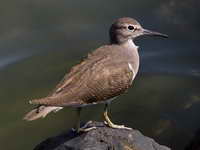

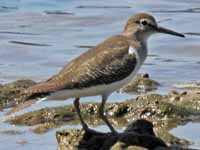
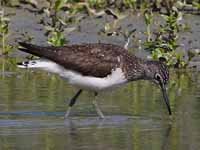

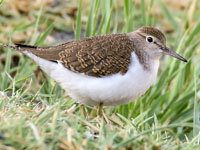
Sandpiper,_Spotted Actitis macularia Found: The Americas
The Spotted Sandpiper has brown upperparts, white underparts, short yellowish legs, orange bill with a dark tip. Breeding birds have spots on the underparts.
Similar to: Common Sandpiper. Their ranges rarely overlap. Common Sandpipers have darker legs than Spotted Sandpipers.
Image by: 1) Pat and Keith Taylor 2, 3) Alan D Wilson - Richmond, British Columbia 4) Winnu 5) Becky_Matsubara - California 6) Alan - California 7) Dick - North Carolina 8) Dick - Puerto Rico 9) Dick - Florida 10) Dick - Panama Similar to: Common Sandpiper. Their ranges rarely overlap. Common Sandpipers have darker legs than Spotted Sandpipers.
1) Juvenile 2, 3, 4) Breeding
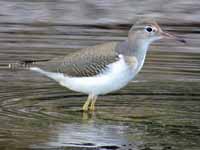

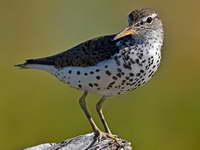
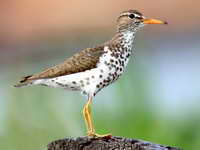
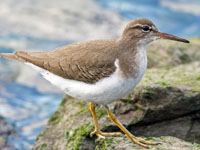
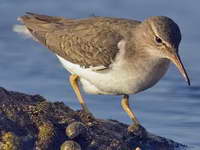
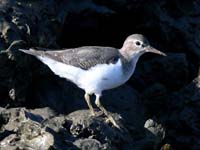
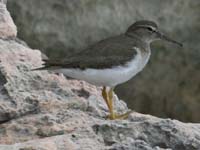
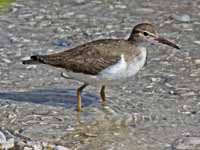
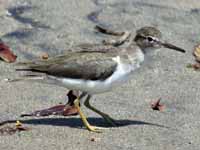
Genus Bartramia - 1 species
Sandpiper,_Upland Bartramia longicauda Found: The Americas
The Upland Sandpiper has marbled black and brown back; similarly for the wings, breast, and flanks, It has white belly, white eye-ring,long yellow legs.
Similar to: Short-billed Dowitcher, Lesser Yellowlegs. Upland Sandpiper are found around grassy environments unlike other similar birds that are usually found around water.
Image by: 1) Pesayo 2) Johnath - Ontario, Canada 3) Dario
Niz - Uruguay 4) Claudio TimmSimilar to: Short-billed Dowitcher, Lesser Yellowlegs. Upland Sandpiper are found around grassy environments unlike other similar birds that are usually found around water.
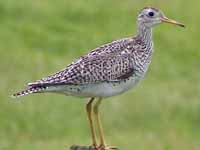
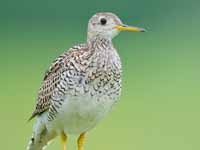


Genus Coenocorypha
The New Zealand Snipes are only found on islands around New Zealand. It is unclear how closely related they are to the Gallinago snipes.
Snipe,_Chatham_Islands Coenocorypha pusilla Found: Chatham Islands of New Zealand
Image by: 1) Walter_Buller 2) jan_veenstra
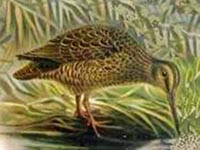
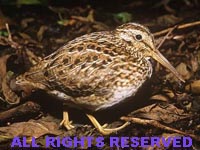
Snipe,_Snares_Island Coenocorypha huegeli Found: Snares Islands (subantarctic islands south of New Zealand).
The Snares Island Snipe has bars, stripes and spots in shades of brown ranging from buffy-white to nearly black, with longitudinal stripes on the face and crown.Males (females) have yellow (olive) colored legs.
Image by: 1, 2) TheyLookLikeUs (Jake Osborne) 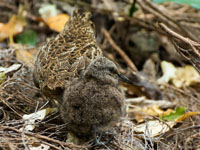
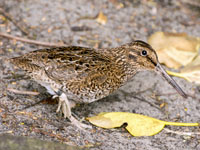
Snipe,_Subantarctic also Aukland Snipe Coenocorypha aucklandica Found: New Zealand
Image by: 1) Characters
1) C. a. perseverance, Campbell Snipe, on Campbell Island
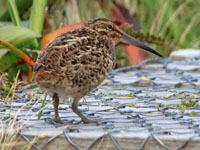
Genus Gallinago
The True Snipes have long bills and camouflage coloring, See also the New Zealand Snipes and Painted Snipes.
Snipe,_African Gallinago nigripennis Found: Africa
The African Snipe has mottled brown upperparts with light lines down the back; dark stripe from rear of eye with white stripes above and below; white belly with some brown barring on flanks but never on belly; pinkish-brown long bill; yellow-olive to greenish-gray legs.
Image by: 1) Ian White 2) Paul Bernard 3, 4) Derek_Keats - South Africa
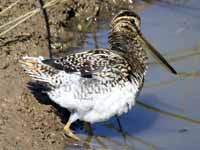

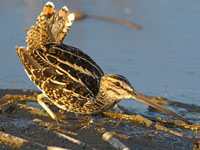
Snipe,_Andean also Jameson Snipe Gallinago jamesoni Found: Andes of South America
The Andean Snipe has mainly brown plumage streaked and patterned with brown and buff; gold edges to feathers form lines down the back; white belly with brown barring; horn-colored bill; yellowish-green legs.
Image by:1) Cornell_Univ's_Neotropical_Birds_Online - Dusan_Brinkhuizen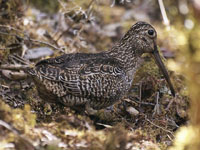
Snipe,_Common Gallinago gallinago Found: North America (Alaska), South America (northwest), Europe, Asia, Africa Indonesia
The Common Snipe has short greenish-gray legs, very long straight dark bill, mottled brown body, dark stripe through the eye with light stripes above and below.
Similar to South American Snipe. It is difficult to distinguish the South American Snipe in the field from wintering Common Snipe, although they can be separated in the hand.
Similar to Wilson's Snipe. Wilson's and the Common Snipe were previously considered to be one species. Common Snipes usually have 7 pairs of tail feathers while Wilson Snipes have 8 pairs. The easist way to tell them apart is by location: Common are predominately Old World and Wilson's are predominately New World.
Image by: 1) Agustin_Povedano 2) sjahanmi - dubai 3) Davis Kwan - Hong Kong 4) AlpsdakeSimilar to South American Snipe. It is difficult to distinguish the South American Snipe in the field from wintering Common Snipe, although they can be separated in the hand.
Similar to Wilson's Snipe. Wilson's and the Common Snipe were previously considered to be one species. Common Snipes usually have 7 pairs of tail feathers while Wilson Snipes have 8 pairs. The easist way to tell them apart is by location: Common are predominately Old World and Wilson's are predominately New World.


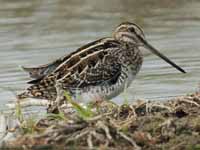
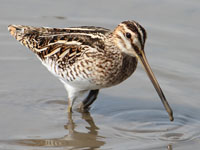
Snipe,_Fuegian Gallinago stricklandii Found: southern South America
The Fuegian Snipe has mottled brown upperparts with ill-defined stripes; buff belly with brown barring on flanks; horn-colored bill; yellowish-green feet.
Image by: 1) Bastian_Gygli - Chile 2) Cornell_Univ's_Neotropical_Birds_Online - Fabrice_Schmitt im Chile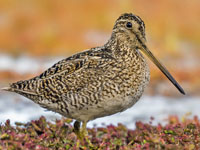
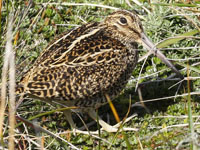
Snipe,_Giant Gallinago undulata Found: South America
Image by: 1, 2) Cornell_Univ's_Neotropical_Birds_Online - Joao_Quental, Ciro_Albano in Brazil
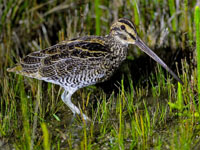
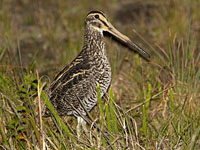
Snipe,_Great Gallinago media Found: Europe, Asia, Africa
The Great Snipe has mottled brown upperparts; dark stripe through eye; white supercilium.
Image by: 1) Thho46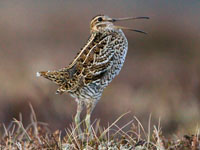
Snipe,_Imperial Gallinago imperialis Found: Andes of South America
The Imperial Snipe has mainly rufous plumage; white belly with heavy brown barrng; long gray bill; gray legs.
Image by: 1) Joseph Smit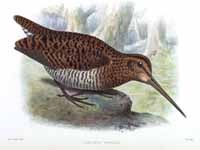
Snipe,_Latham's Gallinago hardwickii Found: Asia, Australasia
The Latham's Snipe has mottled brown, black and buff upperparts; blurry light brown streaks on breast; white belly.
Similar to; Pin-tailed Snipe. Latham's Snipe has longer bill than Pin-tailed Snipe.
Similar to: Swinhoe's Snipe. Latham's Snipe has blurry light brown streaks on breast; Swinhe's Snipe has small dark brown dots on breast.
Image by: 1) Jason Girvan - Australia 2) Oystercatcher - Canberra 3) Mdekool - Australia 4) birdsaspoetrySimilar to; Pin-tailed Snipe. Latham's Snipe has longer bill than Pin-tailed Snipe.
Similar to: Swinhoe's Snipe. Latham's Snipe has blurry light brown streaks on breast; Swinhe's Snipe has small dark brown dots on breast.
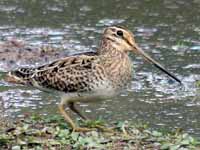
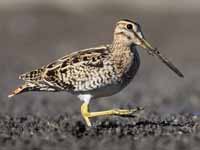
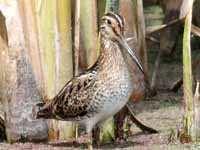

Snipe,_Madsgascar Gallinago macrodactyla Found: Madagascar
The Madagascar Snipe has upperparts, head and neck streaked and patterned with bold dark brown stripes and gold edges to the feathers forming lines down its back;; white belly with some brown barring (not on belly); yellowish-olive to greenish-gray legs.
Image by: 1) Jerry_Oldenettel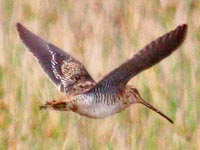
Snipe,_Noble Gallinago nobilis Found: South America
The Noble Snipe has mottled brown upperparts; dark stripe through the eye with light stripes above and below; white belly with brown barring on flanks.
Image by: 1) Alejandro_Tamayo - Columbia 2) Columbia Travel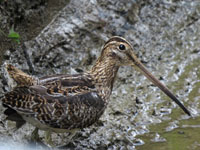

Snipe,_Pin-tailed Gallinago stenura Found: Asia, Africa, Indonesia
The Pin-tailed Snipe has mottled brown upperparts with cream lines down the back; streaked buff breast; white belly; dark eye-line with white stripes above and below; greenish-gray legs.
Similar to; Latham's Snipe. Latham's Snipe has longer bill than Pin-tailed Snipe.
Image by: 1) JJ Harrison 2) sfitzgerarld86 - Indonesia 3) Hiyashi Haka 4) Jason_Thompson - ThailandSimilar to; Latham's Snipe. Latham's Snipe has longer bill than Pin-tailed Snipe.
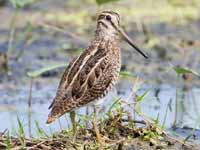
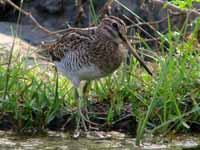
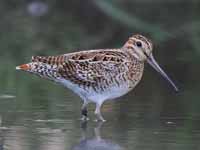
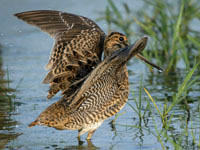
Snipe,_Puna Gallinago andina Found: Argentina, Chile, Peru
The Puna Snipe has upperparts, head and neck streaked and patterned with warm brown and buff, and the gold edges to the feathers form lines down its back; white belly with brown barring; yellow legs.
Image by: 1) Amy_McAndrews 2) Luis Fernandez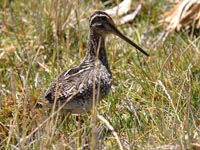
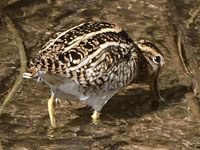
Snipe,_Solitary Gallinago solitaria Found: eastern Asia
The Solitary Snipe has streaked and patterned upperparts, head, and neck with medium brown stripes and whitish edges to the feathers forming lines down its back; whitish face; ginger-brown breast; white belly with brown barring on flanks; brown and black long straight bill.
Image by: 1) ken 2) Jainy_Kuriakose - India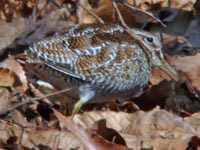
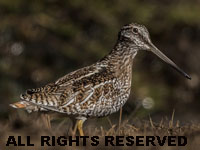
Snipe,_South_American Gallinago paraguaiae Found: South America
The South American Snipe has short greenish-gray legs, very long straight dark bill, mottled brown body, dark stripe through the eye with light stripes above and below it.
Similar to Common Snipe. It is difficult to distinguish the South American Snipe in the field from wintering Common Snipe, although they can be separated in the hand.
Image by: 1, 2) Cláudio Timm - Rio Grande do Sul, Brazil 3) Nick Athanas - Brazil 4) Qwuito - BrazilSimilar to Common Snipe. It is difficult to distinguish the South American Snipe in the field from wintering Common Snipe, although they can be separated in the hand.
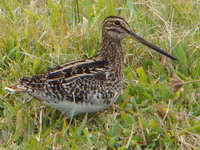


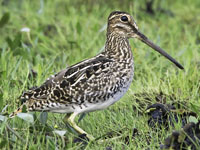
Snipe,_Swinhoe's also Chinese Snipe Gallinago megala Found: Asia, Australasia
The Swinhoe's Snipe has mottled brown, black and buff upperparts; small dark brown dots on breast; white belly.
Similar to: Latham's Snipe. Latham's Snipe has blurry light brown streaks on breast; Swinhe's Snipe has small dark brown dots on breast.
Image by: 1) Hiyashi Haka 2) watch-bird.blogspot.tw Similar to: Latham's Snipe. Latham's Snipe has blurry light brown streaks on breast; Swinhe's Snipe has small dark brown dots on breast.
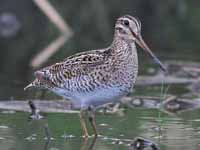
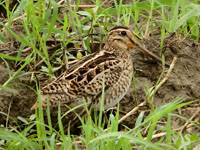
Snipe,_Wilson's Gallinago delicata Found: The Americas, Europe (vagrant)
The Wilson's Snipe has short greenish-gray legs, very long straight dark bill, mottled brown body, dark stripe through the eye with light stripes above and below it.
Similar to American Woodcock. American Woodcock and Wilson's Snipe have similar body structure, but are quite different in markings.
Similar to: Common Snipe. Wilson's and the Common Snipe were previously considered to be one species. Common Snipes usually have 7 pairs of tail feathers while Wilson Snipes have 8 pairs. The easist way to tell them apart is by location: Common are predominately Old World and Wilson's are predominately New World.
Image by: 1) Sean Breazeal - Central Utah 2, 3, 4) Alan D Wilson -Near Burns, Oregon
5) Linda Westerinen - California 6) Becky_Matsubara - CA 7) Dick - AshSimilar to American Woodcock. American Woodcock and Wilson's Snipe have similar body structure, but are quite different in markings.
Similar to: Common Snipe. Wilson's and the Common Snipe were previously considered to be one species. Common Snipes usually have 7 pairs of tail feathers while Wilson Snipes have 8 pairs. The easist way to tell them apart is by location: Common are predominately Old World and Wilson's are predominately New World.
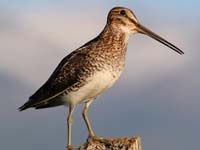
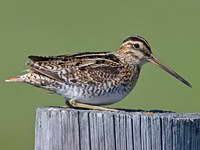
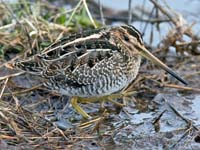
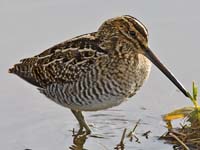
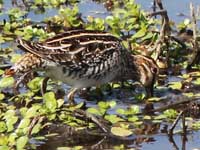
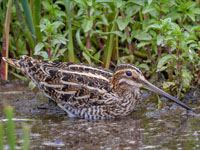
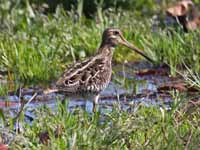
Snipe,_Wood Gallinago nemoricola Found: Asia
Compared to other snipes, Wood Snipe has dark upperparts and short bill.
Image by: 1) Herbert 2) Tang Jun 3) Ulrich_Weber - China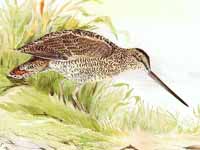
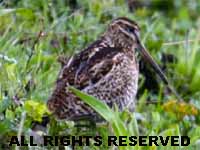
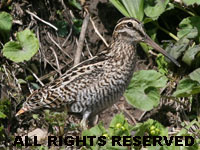
Genus Limnodromus
The dowitchers are medium-sized long-billed wading birds. They resemble godwits in body and bill shape, but are much shorter legged.
Similar to: Curlews. Curlews have down-curved bill; Dowitchers have straight bills.
Similar to: Godwits. Godwits have darker legs than Dowitchers.
Dowitcher, Asian Limnodromus semipalmatus Found: Asia, Australasia >
The breeding Asian Dowitcher has brown upperparts; reddish underparts. Nonbreeding has mainly gray plumage.
Similar to: Bar-tailed Godwit. The Bar-tailed Godwit has a "sewing machine" feeding action and yelping call.
Image by: 1) Charles Lam 2) Ainus - Taiwan 3) Changhua Coast Conservation 4) charactersSimilar to: Bar-tailed Godwit. The Bar-tailed Godwit has a "sewing machine" feeding action and yelping call.
1) Nonbreeding 2, 3, 4) Breeding
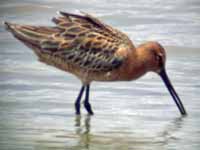
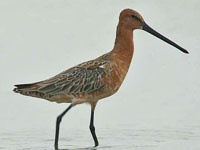
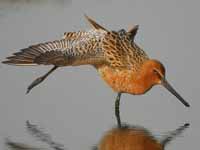
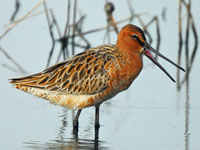
Dowitcher, Long-billed Limnodromus scolopaceus Found: North America, Asia. Rare: South America, Europe, Africa
When breeding, the Long-billed Dowitcher Adults has dark brown upperparts, light underparts with spotted throat and breast, long straight dark bill, black and white barred tail, yellowish legs. The winter plumage is largely gray.
Similar to: Short-billed Dowitcher. Very difficult to distinguish by appearance; bill length may help but it is not conclusive. Long-billed Dowitcher more likely to be found near fresh water than Short-billed. Voice is best means of identification: Short-billed Dowitcher has a more mellow call.
Image by: 1) Len Blumin - California 2) J N Stuart - New Mexico 3) Rick Leche 4) Maggie Smith - California 5) Winnu - Washington 6) Alan D. Wilson 7) Dick - Sanibel Island, FloridaSimilar to: Short-billed Dowitcher. Very difficult to distinguish by appearance; bill length may help but it is not conclusive. Long-billed Dowitcher more likely to be found near fresh water than Short-billed. Voice is best means of identification: Short-billed Dowitcher has a more mellow call.
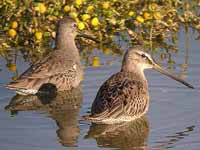
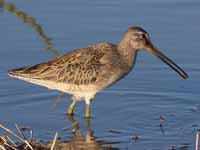
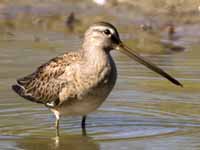

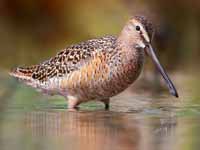
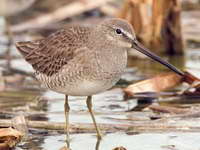
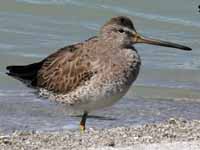
Dowitcher, Short-billed Limnodromus griseus Found: The Americas, Europe (rare)
When breeding, the Short-billed Dowitcher Adults has dark brown upperparts, light underparts with spotted throat and breast, long straight dark bill, black and white barred tail, yellowish legs. The winter plumage is largely gray.
Similar to: Long-billed Dowitcher. Very difficult to distinguish by appearance; bill length may help but it is not conclusive. Long-billed Dowitcher more likely to be found near fresh water than Short-billed. Voice is best means of identification: Short-billed Dowitcher has a more mellow call.
Similar to: Upland Sandpiper. Upland Sandpiper are found around grassy environments unlike other similar birds that are usually found around water.
Image by: 1, 2, 3, 4, 5, 6, 7, 8, 9, 10, 11, 12, 13, 14) Dick - Sunset Beach, North Carolina Andy_MorffewSimilar to: Long-billed Dowitcher. Very difficult to distinguish by appearance; bill length may help but it is not conclusive. Long-billed Dowitcher more likely to be found near fresh water than Short-billed. Voice is best means of identification: Short-billed Dowitcher has a more mellow call.
Similar to: Upland Sandpiper. Upland Sandpiper are found around grassy environments unlike other similar birds that are usually found around water.
9, 10, 11) Breeding
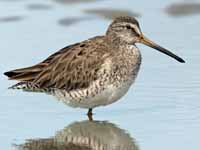
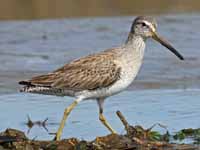
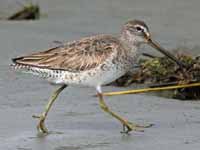

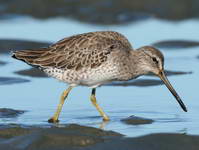
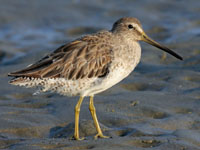
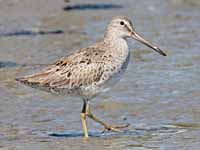
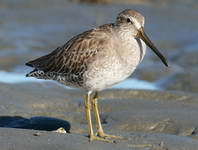
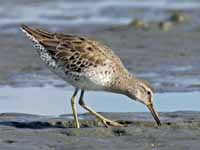
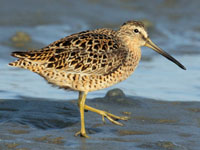

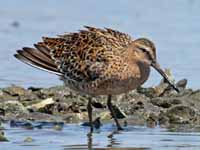
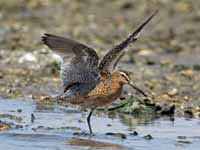

Genus Limosa
The godwits are large, long-billed, long-legged and strongly migratory waders of the bird genus Limosa. Their long bills allow them to probe deeply in the sand for aquatic worms and molluscs.
Similar to: Curlews. Curlews have down-curved bill; Godwits have up-curved bill.
Similar to: Dowitchers. Godwits have darker legs than Dowitchers.
Godwit,_Bar-tailed Limosa lapponica Found: North America, Europe, Asia, Africa, Australia
The Bar-tailed Godwit has mottled gray back, blue-gray legs, very long dark bill with a slight upward curve and pink at the tip. The neck, breast and belly are unbroken brick red in breeding plumage, off white in winter.
Similar to: Asian Dowitcher. The Bar-tailed Godwit has a "sewing machine" feeding action and yelping call.
Similar to: Black-tailed Godwit. Bar-tailed Godwit has bars on tail, Black-tailed Godwit has black on end of tail. Nonbreeding Black-tailed Godwit has uniform gray upperparts; Bar-tailed Godwit has streaked back.Black-tailed Godwit has white underwing.
Similar to: Hudsonian Godwit. Bar-tailed Godwit has bars on tail, Hudsonian has black on end of tail. Nonbreeding Hudsonian Godwit has uniform gray upperparts; Bar-tailed Godwit has streaked back. Hudsonian has dark underwing.
Similar to: Marbled Godwit. Marbled Godwit upperparts have more uniformed speckling than other godwits.
Image by: 1) Australia Bill Bouton - California 4, 5) Dick - Australia 3) Oysterctcher - California 6, 7) Tim Bowman, US Fish and Wildlife
Service 8) Hillary Chambers - Great Britain 2, 9) Cristiano Crolle - Texel, Holland Similar to: Asian Dowitcher. The Bar-tailed Godwit has a "sewing machine" feeding action and yelping call.
Similar to: Black-tailed Godwit. Bar-tailed Godwit has bars on tail, Black-tailed Godwit has black on end of tail. Nonbreeding Black-tailed Godwit has uniform gray upperparts; Bar-tailed Godwit has streaked back.Black-tailed Godwit has white underwing.
Similar to: Hudsonian Godwit. Bar-tailed Godwit has bars on tail, Hudsonian has black on end of tail. Nonbreeding Hudsonian Godwit has uniform gray upperparts; Bar-tailed Godwit has streaked back. Hudsonian has dark underwing.
Similar to: Marbled Godwit. Marbled Godwit upperparts have more uniformed speckling than other godwits.
1, 2) Juvenile 2 - 5) Nonbreeding or female 5) Bar-tailed Godwit and Dunlin 6, 7) Male breeding 8) shows bar-tail.

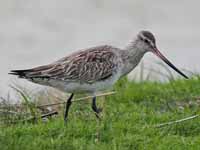
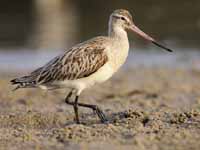
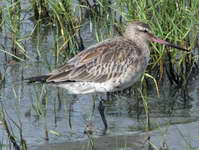
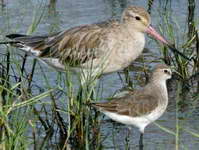
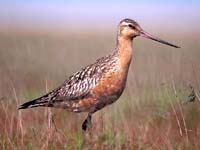
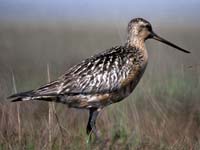

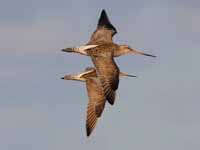
Godwit,_Black-tailed Limosa limosa Found: North America (infrequent), Europe, Asia, Africa, Australia
Similar to: Bar-tailed Godwit. Bar-tailed Godwit has bars on tail, Black-tailed Godwit has black on end of tail. Nonbreeding Black-tailed Godwit has uniform gray upperparts; Bar-tailed Godwit has streaked back.
Similar to: Hudsonian Godwit. Black-tailed Godwit has white underwing; Hudsonian has dark underwing.
Similar to: Marbled Godwit. Marbled Godwit upperparts have more uniformed speckling than other godwits.
Image by: 1) Ranbir Mahapatra 2, 9) Agustin_Povedano 3) Dick Daniels - Australia 4) Ómar Runólfsson - Iceland
5, 6) Frank Vassen - Poland 7)
Hans Hillewaert - Uitkerkse Polders, Belgium 8) Cristiano Crolle - Texel, Holland Similar to: Hudsonian Godwit. Black-tailed Godwit has white underwing; Hudsonian has dark underwing.
Similar to: Marbled Godwit. Marbled Godwit upperparts have more uniformed speckling than other godwits.
1, 2, 3) Nonbreeding 4 - 8) Breeding
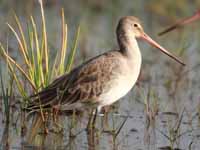

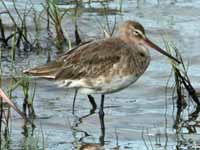
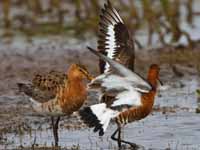
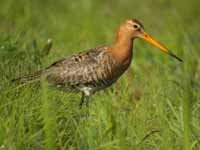

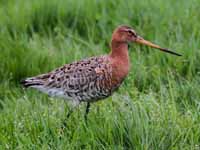
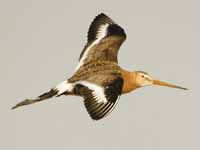
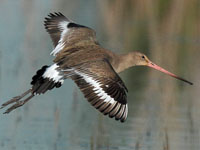
Godwit,_Hudsonian Limosa haemastica Found: The Americas, Australia (vagrant)
The Hudsonian Godwit has mottled brown upperparts, chestnut underparts, long pink bill with a slight upward curve and dark at the tip, black tail, white rump, dark legs.
Similar to: Bar-tailed Godwit. Bar-tailed Godwit has bars on tail, Hudsonian has black on end of tail. Nonbreeding Hudsonian Godwit has uniform gray upperparts; Bar-tailed Godwit has streaked back. Hudsonian has dark underwing.
Similar to: Black-tailed Godwit. Black-tailed Godwit has white underwing; Hudsonian has dark underwing.
Similar to: Marbled Godwit. Marbled Godwit upperparts have more uniformed speckling than other godwits.
Image by: 1) nebirdsplus - Massachusetts 2, 3) Cláudio Timm - Rio Grande do Sul, Brazil 4) Bill Bouton - Manitoba, CASimilar to: Bar-tailed Godwit. Bar-tailed Godwit has bars on tail, Hudsonian has black on end of tail. Nonbreeding Hudsonian Godwit has uniform gray upperparts; Bar-tailed Godwit has streaked back. Hudsonian has dark underwing.
Similar to: Black-tailed Godwit. Black-tailed Godwit has white underwing; Hudsonian has dark underwing.
Similar to: Marbled Godwit. Marbled Godwit upperparts have more uniformed speckling than other godwits.
1, 2, 3) Nonbreeding 4) Breeding
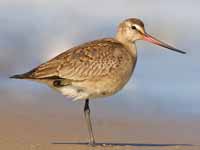
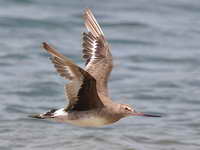
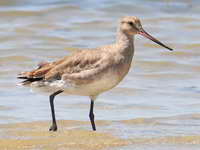
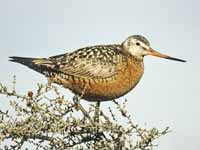
Godwit,_Marbled Limosa fedoa Found: The Americas
The Marbled Godwit has dark mottled back, pale brown breast with dark bars, pale brown belly, very long pink bill with a slight upward curve and dark at the tip, long blue-gray legs.
Similar to: Bar-tailed Godwit, Black-tailed Godwit, Hudsonian Godwit. Marbled Godwit upperparts have more uniformed speckling than other godwits.
Image by: 1, 2, 5) Dick Daniels- Monterey, California 3) Dick - Half Moon Bay, CA 4) Dick - Arizona 6) Alan D. Wilson - Huntington Beach, California 7) Len Blumin - Californina 8) Alan D Wilson - Huntington BeachSimilar to: Bar-tailed Godwit, Black-tailed Godwit, Hudsonian Godwit. Marbled Godwit upperparts have more uniformed speckling than other godwits.
1 - 5) Nonbreeding 6, 7) Breeding
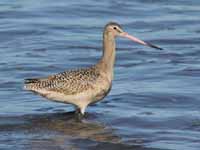

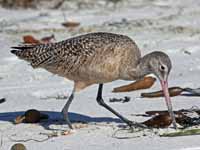

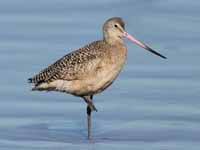
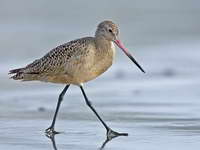
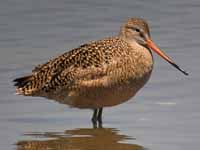
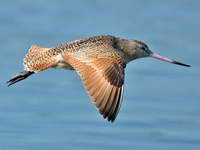
Genus Lymnocryptes - 1 species
Snipe,_Jack Lymnocryptes minimus Found: Europe, Asia, Africa
The Jack Snipe has mottled brown upperparts with cream-colored stripes; pale underparts. The head pattern differs from snipes in genus Gallinago in that it has no central crown stripe. It is the smallest snipe.
Image by: 1) Marek Szczepanek 2) Durzan Cirano 3) Natural_England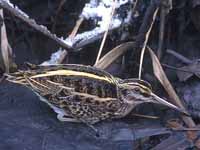
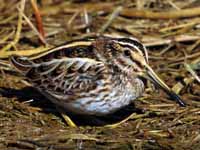
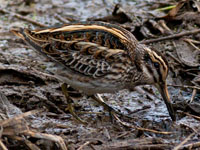
Genus Numenius
The curlews have long, slender, downcurved bills and mottled brown plumage.
Similar to: Dowitchers. Curlews have down-curved bill; Dowitchers have straight bill.
Similar to: Godwits. Curlews have down-curved bill; Godwits have up-curved bill.
Curlew also Eurasian Curlew Numenius arquata Found: Europe, Asia
The Eurasian Curlew is mainly grayish brown, with a white back, and a very long curved bill.
Similar to: Whimbrel. The Whimbrel is smaller than the Eurasian Curlew and has a shorter bill.
Image by: 1) AngMoKio - the Stuttgart Zoo 2) Andreas_Trepte
3) Darren
Bellerby - Hong Kong Wetland Park, Hong Kong 4) Cristiano Crolle - Racconigi, Italy 5) Andi_LiSimilar to: Whimbrel. The Whimbrel is smaller than the Eurasian Curlew and has a shorter bill.
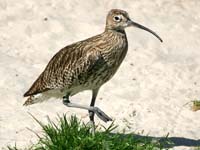
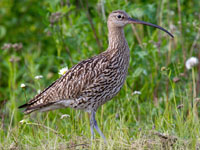

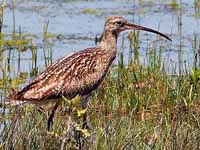
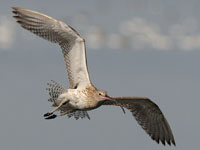
Curlew, Bristle-thighed Numenius tahitiensis Found: west coast North America and some tropical Pacific islands
The Bristle-thighed Curlew has a spotted brown upperbody, light belly, long bill, bristled feathers at the base of the legs.
Similar to: Whimbrel. The Whimbrel and Bristle-thighed Curlew are about the same size and shape. They both have a pale stipe on the head. The Bristle-thighed Curlew has an unmarked pale belly, the Whimbrel's belly is marked.
Image by: 1) Mick_Thompson - Nome, Alaska 2) Kristine Sowl - Alaska 3) USFWS 4) Charlie Westerinen - Half Moon Bay, California Similar to: Whimbrel. The Whimbrel and Bristle-thighed Curlew are about the same size and shape. They both have a pale stipe on the head. The Bristle-thighed Curlew has an unmarked pale belly, the Whimbrel's belly is marked.
4) Rare to California. Bird in back is a Black Oystercatcher.
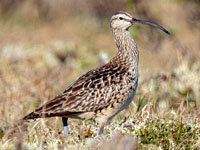
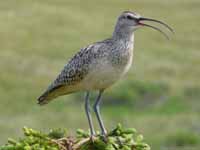
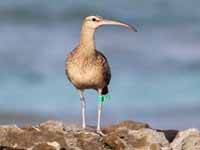
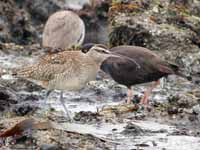
Curlew, Eastern also Far Eastern Curlew Numenius madagascariensis Found: Asia, Australia, New Zealand
One of the largest curlews and one of the largest curlew bills. Differentiated from other curlews by its plain, unpatterned brown underwing.
Image by: 1, 2, 3, 4) Dick Daniels - Cairns, Australia 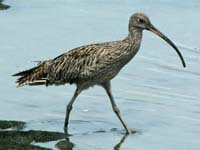
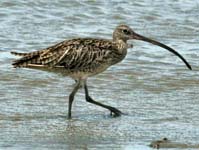
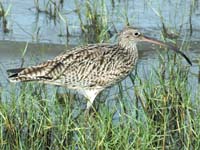
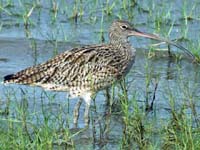
Curlew, Little Numenius minutus Found: Asia, Australasia
IThe Little Curlew is mainly grayish brown, including the underwings, with a white belly, and a short, for a curlew, curved bill. It has a head pattern like a Whimbrel, with crown and superciliary stripes
Image by: 1) Wayne Cheng 2, 3) Hyashi Haka 4) characters - Taiwan
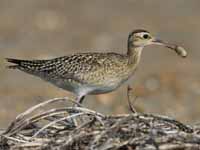

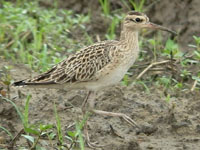
Curlew, Long-billed Numenius americanus Found: North America
The Long-billed Curlew has a very long downwards curved bill, long neck, small head, light cinnamon neck and underparts, brown streaked crown.
Similar to: Whimbrel. Whimbrel has striped head; Long-billed Curlew has no head stripe. Long-billed Curlew has longer bill. The Long-billed Curlew has a buffy breast and belly, versus grayish brown for the Whimbrel.
Image by: 1) John Crotty - California 2) Len Blumin - California 3) Mike Baird - California 4, 5, 6) Dick Daniels - California 7) Charlie Westerinen - Texas Similar to: Whimbrel. Whimbrel has striped head; Long-billed Curlew has no head stripe. Long-billed Curlew has longer bill. The Long-billed Curlew has a buffy breast and belly, versus grayish brown for the Whimbrel.
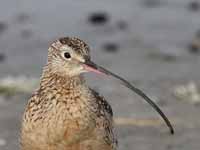
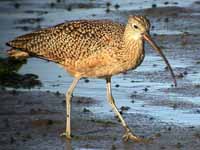
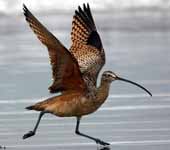
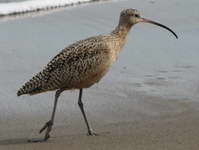
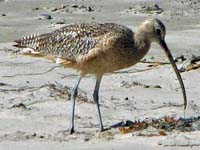
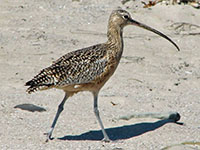
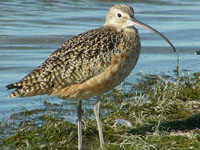
Curlew, Slender-billed Numenius tenuirostris Found: Northern Africa
The Slender-billed Curlew was last seen in 2007 and may now be extinct.
Image by: 1) Gould and Lear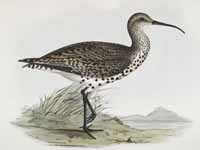
Whimbrel Numenius phaeopus Found: The Americas, Europe, Asia, Africa, Australasia
The Whimbrel is mainly grayish brown. It has a long curved bill with a kink rather than a smooth curve. It also has a central crown stripe and strong supercilia.
Similar to: Bristle-thighed Curlew. The Whimbrel and Bristle-thighed Curlew are about the same size and shape. They both have a pale stipe on the head. The Bristle-thighed Curlew has an unmarked pale belly, the Whimbrel's belly is marked.
Similar to: Eurasian Curlew. The Whimbrel is smaller than the Eurasian Curlew and has a shorter bill.
Similar to: Long-billed Curlew. Whimbrel has striped head; Long-billed Curlew has no head stripe. Long-billed Curlew has longer bill. The Long-billed Curlew has a buffy breast and belly, versus grayish brown for the Whimbrel.
Image by: 1, 2, 3) Dick Daniels - Half Moon Bay, California 4) Dick - Galapagos Islands 5) Dick - Panama 6, 7) Dick - Madagascar 8) Dick - Chile 9) Elaine R. Wilson - La Jolla, CaliforniaSimilar to: Bristle-thighed Curlew. The Whimbrel and Bristle-thighed Curlew are about the same size and shape. They both have a pale stipe on the head. The Bristle-thighed Curlew has an unmarked pale belly, the Whimbrel's belly is marked.
Similar to: Eurasian Curlew. The Whimbrel is smaller than the Eurasian Curlew and has a shorter bill.
Similar to: Long-billed Curlew. Whimbrel has striped head; Long-billed Curlew has no head stripe. Long-billed Curlew has longer bill. The Long-billed Curlew has a buffy breast and belly, versus grayish brown for the Whimbrel.
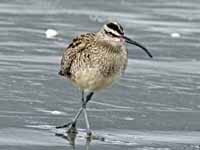
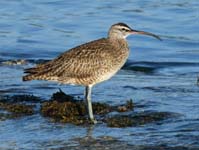
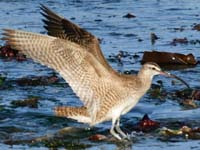
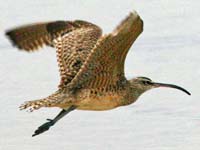
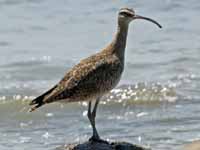
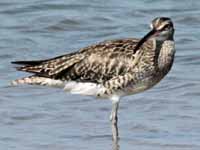
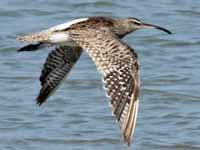
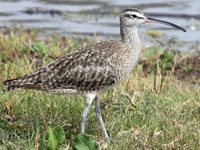
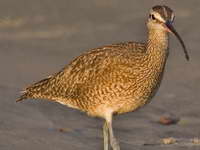
Genus Phalaropus
Phalaropes are unusual amongst shorebirds in that they are pelagic - they spend a great deal of their lives outside the breeding season well out to sea. Phalaropes are unusually salt-loving and feed in great numbers in saline lakes.
Phalarope,_Red Phalaropus fulicarius Found: The Americas, Europe, Asia, Africa
The Red Phalarope has lobed toes, straight bill. The breeding bird has a yellow bill tipped with black. The breeding female has dark brown and black above, red underparts, white cheek patches. The breeding male is a duller version of the female. In winter the birds have gray above, white below, black bill. Young birds are light gray and brown above, with buff underparts.
Similar to: Red-necked Phalarope. Nonbreeding Red Phalarope has a unstreaked gray back; nonbreeding Red-necked Phalarope has streaked gray back. Breeding Red Phalarope has red throat; breeding Red-necked Phalarope has white throat.
Image by: 1) Billy Liar - West Virginia 2) Lee Karney
3) Maggie Smith 4) Nik_Borrow - UK 5, 6) Mke Baird - Morro Bay, California 7) Allan_Hopkins 8) Andrei Taranchenko - Alaska Similar to: Red-necked Phalarope. Nonbreeding Red Phalarope has a unstreaked gray back; nonbreeding Red-necked Phalarope has streaked gray back. Breeding Red Phalarope has red throat; breeding Red-necked Phalarope has white throat.
1 - 4) Nonbreeding 5) Breeding female 6 - 8) Breeding male
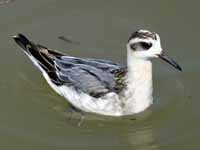
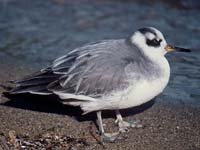
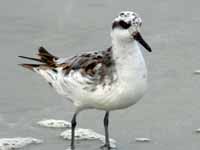
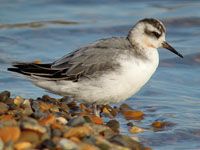
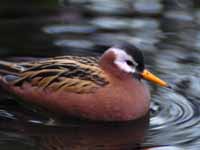

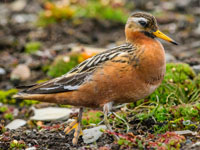
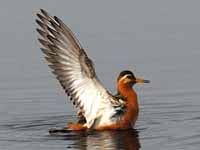
Phalarope,_Red-necked Phalaropus lobatus Found: The Americas, Europe, Asia, Africa
The Red-necked Phalarope has lobed toes, straight fine black bill. The breeding female has dark gray above, red neck and upper breast, black face, white throat. The breeding male is a duller version of the female. In winter the birds have gray above, white below. Young birds are gray and brown above, with buff underparts and a black patch through the eye.
Image by: 1, 2) Dick Daniels - Seward, Alaska 3) Omar Runolfsson - Iceland 4) Ainus 5, 8) Mike Baird - California 6, 9) Alan D Wilson - Malheur National Wildlife Refuge, Oregon 7) USFWS1, 2) Juvenile 3, 4) Nonbreeding 5) Eclipse female 7) Breeding female 9) Breeding Male
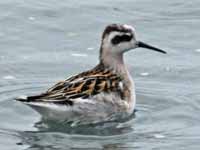
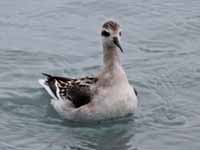

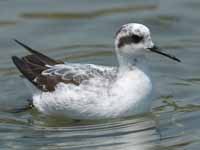
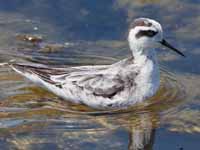
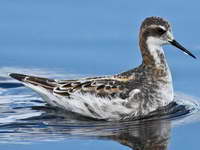
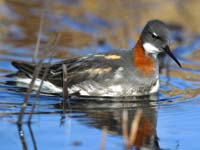

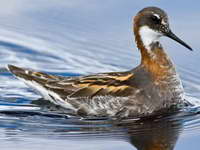
Phalarope,_Wilson's Phalaropus tricolor Found: The Americas, Europe
The Wilson's Phalarope has lobed toes, straight fine black bill. The breeding female has gray and brown above, white underparts, reddish neck, reddish flank patches. The breeding male is a duller version of the female, with a brown back, and the reddish patches reduced or absent.
Similar to: Stilt Sandpiper. Nonbreeding Stilt Sandpipers and nonbreeding Wilson's Phalarope are similar. Wilson's Phalarope has white underparts; Stilt Sandpiper has gray breast.
Image by: 1) J N Stuart 2) Amy McAndrews - Mexico 3) Ken Schneider - California 4) Dick Daniels - Puno, Peru 5) Dominic
Sherony 6) Alan D. Wilson - Oregon 7) Jerry Oldenettel - New Mexico 8) Jason Crotty - CaliforniaSimilar to: Stilt Sandpiper. Nonbreeding Stilt Sandpipers and nonbreeding Wilson's Phalarope are similar. Wilson's Phalarope has white underparts; Stilt Sandpiper has gray breast.
1) Juvenile 2) Juvenile eclipse 3, 4) Nonbreeding 5, 6) Female breeding 7, 8) Male breeding
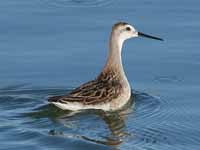
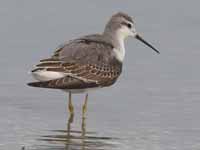
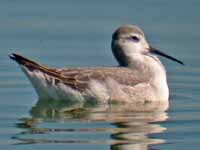
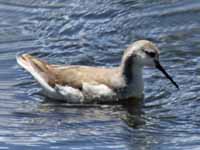
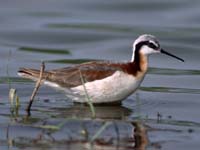
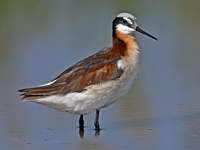
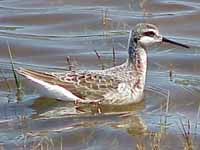
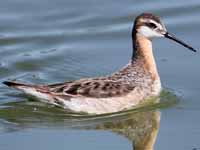
Genus Scolopax
Woodcocks have stocky bodies, cryptic brown and blackish plumage and long slender bills. Their eyes are located on the sides of their heads, which gives them nearly 360° vision. Unlike in most birds, the tip of the bill's upper mandible is flexible.As their common name implies, the woodcocks are woodland birds. They feed at night or in the evenings, searching for invertebrates in soft ground with their long bills. This habit and their unobtrusive plumage makes it difficult to see them when they are resting in the day.
Woodcock,_Amami Scolopax mira Found: Amami Islands of south Japan
Image by: 1) Momtarou2012 2) Daniel Smith 3) Pete_Morris
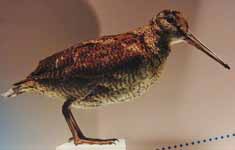
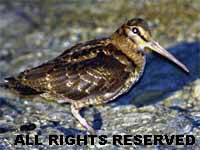
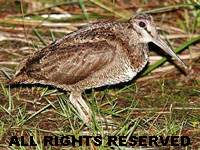
Woodcock,_American Scolopax minor Found: east North America
The American Woodcock is found in forest undergrowth. It has a long bill, short tail.
Similar to: Wilson's Snipe. American Woodcock and Wilson's Snipe have similar body structure, but are quite different in markings.
Image by: 1) Phil Brown - Massachuetts 2) Will_Pollard 3) Paco Lyptic - Minnesota 4) Jerry Oldenettel - Michigan 5) Audrey 6) Dick Daniels - New HampshireSimilar to: Wilson's Snipe. American Woodcock and Wilson's Snipe have similar body structure, but are quite different in markings.
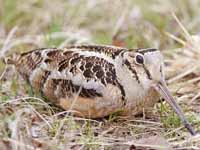
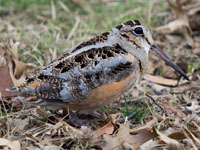
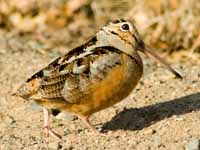
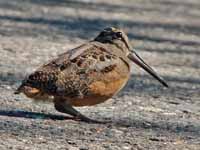
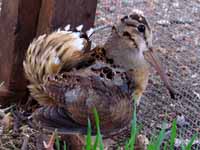
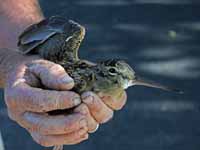
Woodcock,_Bukidnon Scolopax bukidnonensis Found: Mindanao and Luzon of the Philippines
The Bukidnon Woodcook has reddish-brown upperparts vermiculated with black and broadly barred; paler and buffer underparts.
Image by: 1) Bram_Demeulemeester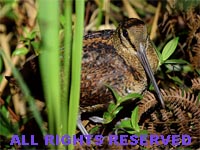
Woodcock,_Eurasian Scolopax rusticola Found: temperate to subarctic Eurasia
The Eurasian Woodcook has reddish-brown upperparts; buff colored underparts.
Image by: 1) Ronald Stabke 2) Sylvia Duckworth 3) Roger_Sanderson - England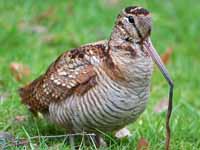

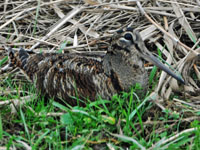
Woodcock,_Javan Scolopax saturata Found: Sumatra and western Java (Indonesia)
Image by: 1) Dave_Curtis
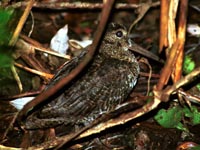
Woodcock,_Moluccan Scolopax rochussenii Found: small islands in North Maluku of Indonesia
The Moluccan Woodcock has black barred upperparts; orange-buff underparts.
Image by: 1) Paulo_Alves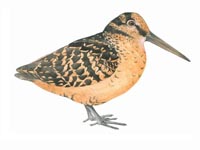
Woodcock,_New_Guinea Scolopax rosenbergii Found: New Guinea
The New Guinea Woodcook has mainly dark plumage; white belly patch.
Image by: 1, 2) Katerina_Tvardikova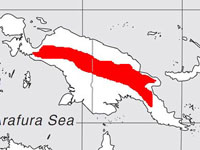
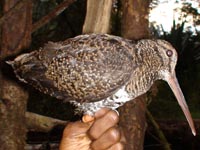
Woodcock,_Sulawesi Scolopax celebensis Found: Sulawesi (Indonesia)
The Sulawesi Wookcook has darker plumage than the Eurasian Woodcook and also has some small reddish spots.
Image by: 1) Salvatore Chamu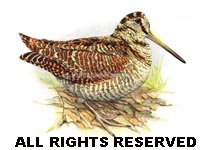
Genus Tringa
They are mainly freshwater or marsh birds and often have brightly colored legs. They tend to breed in Northern Hemisphere.
Greenshank, Common Tringa nebularia Found: North America (rare), Europe, Asia, Africa, Australia, New Zealand
The common Greenshank has long greenish legs; slender upturned bill; white eye-ring. It is brown in breeding plumagel, gray-brown otherwise. They show a white wedge on the back in flight.
Similar to: Greater Yellowlegs. Common Greenshank have green legs; Greater Yellowlegs have yellow legs.
Similar to: Marsh Sandpiper. Common Greenshank has slender upturned bill; Marsh Sandpiper has broader and straighter bill.
Similar to: Spotted Redshank. Common Greenshank have green legs; Spotted Redshank have red legs.
Image by: 1) Ian White - Botswana 2) JJ Harrison - Tasmania, Australia 3) Alastair Rae 4, 5) Dick Daniels - Australia 6) J Dietrich 7, 8) Dick - MadagascarSimilar to: Greater Yellowlegs. Common Greenshank have green legs; Greater Yellowlegs have yellow legs.
Similar to: Marsh Sandpiper. Common Greenshank has slender upturned bill; Marsh Sandpiper has broader and straighter bill.
Similar to: Spotted Redshank. Common Greenshank have green legs; Spotted Redshank have red legs.
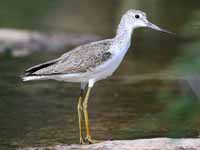
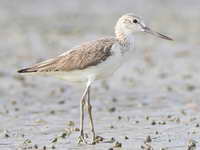
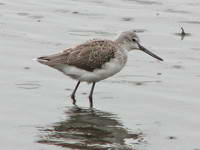
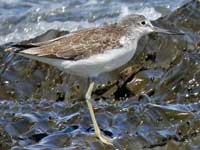
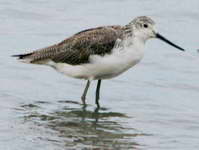
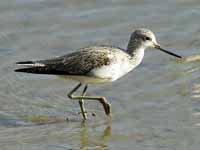
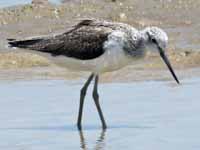
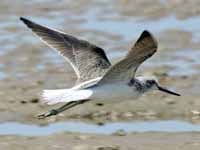
Greenshank, Nordmann's also Spotted Greenshank Tringa guttifer Found: Asia, Indonesia, Malaysia, Philipinnes
The Nordmann's Greenshank has slightly upturned bill; yellow shortish legs. Breeding has white spots on blackish upperparts; heavily streaked head, upper-neck; blackish cresent spots on lower-neck, breast.
Image by: 1) Joseph Smit 2) Len_Worthington - Thailand 3) Frankie Chu 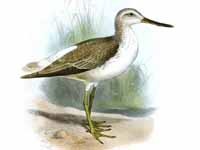
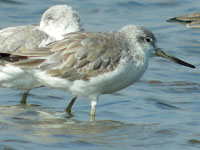
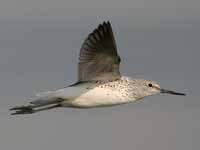
Redshank,_Common Tringa totanus Found: Europe, Asia
The Common Redshank has red legs, black-tipped red bill. The breeding bird has marbled brown color. The nonbreeding bird is plain grayish-brown above and whitish below. They show white up the back and on the wings in flight.
Similar to: Spotted Redshank. Spotted Redshank have longer bill than Common Redshank.
Image by: 1) 4028mdk09 2) Andreas Trepte 3) Frans_Vandewalle - Belgiun 4) Frank
Vassen on the Canary Island of Lanzarote Similar to: Spotted Redshank. Spotted Redshank have longer bill than Common Redshank.
1) Nonbreeding 2, 3, 4) Breeding
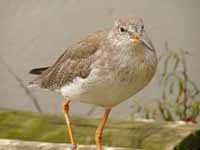
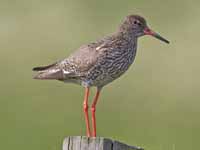
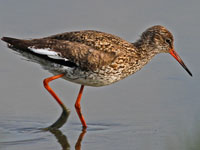
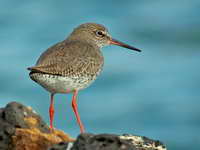
Redshank,_Spotted Tringa erythropus Found: North America (vagrant), Europe, Asia, Africa, Australia
The Spotted Redshank has red legs and bill, shows a white oval on the back in flight. It is black in breeding plumage, and very pale in winter. It . Juveniles are gray-brown finely speckled white above, and have pale, finely barred underparts.
Similar to: Common Greenshank. Common Greenshank have green legs; Spotted Redshank have red legs.
Similar to: Greater Yellowlegs, Lesser Yellowlegs in nonbreeding season. Yellowlegs have yellow legs while Spotted Redshanks have red legs.
Similar to: Common Redshank. Spotted Redshank have longer bill than Common Redshank.
Image by: 1) Lip Kee Yap 2) J M Garg - India 3) Nik_Borrow - England 4) Charles Lam - Hong Kong 5) Frans_Vandewalle - BelgiumSimilar to: Common Greenshank. Common Greenshank have green legs; Spotted Redshank have red legs.
Similar to: Greater Yellowlegs, Lesser Yellowlegs in nonbreeding season. Yellowlegs have yellow legs while Spotted Redshanks have red legs.
Similar to: Common Redshank. Spotted Redshank have longer bill than Common Redshank.
4, 5) Male breeding
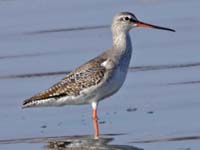
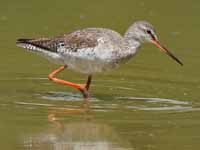
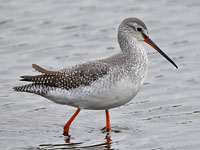
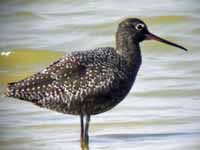
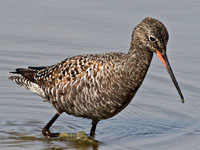
Sandpiper,_Green Tringa ochropus Found: Europe, Asia, Africa
The Green Sandpiper has greenish-brown back and wings; grayish head, breast, white belly; green legs, bill. The back is spotted white to varying extents (most spots when breeding).
Similar to: Solitary Sandpiper. Their ranges rarely overlap.
Similar to: Wood Sandpiper. Wood Sandpiper have a small dull white tail patch in flight; Green Sandpiper have a bright white tail in flight.
Image by: 1, 2)
J M Garg - India 3) Edwyn Anderton 4) Dick Daniels - Lake Naivasha, Kenya 5) Cristiano Crolle - Racconigi, ItalySimilar to: Solitary Sandpiper. Their ranges rarely overlap.
Similar to: Wood Sandpiper. Wood Sandpiper have a small dull white tail patch in flight; Green Sandpiper have a bright white tail in flight.
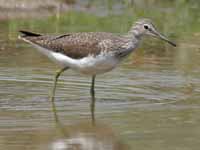
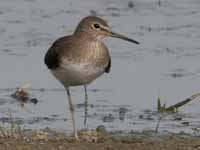

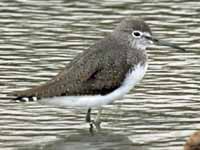
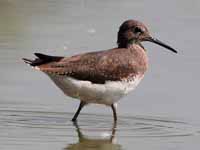
Sandpiper,_Marsh Tringa stagnatilis Found: Europe, Asia, Africa, Australia
The Marsh Sandpiper has a long fine bill; yellowish legs; white eye-rings; white wedge up its back that is visible in flight. It is grayish brown in breeding plumage, paler in winter.
Similar to: Common Greenshank. Common Greenshank has slender upturned bill; Marsh Sandpiper has broader and straighter bill.
Image by: 1) Dick Daniels near Johannesburg, South Africa 1) JJ Harrison - Thailand 2) Jason Girvan - Australia 3) Lin_Sun_Fong - Taiwan 4) Eugene Cheach dec 5) Sergey Yeliseev - Russia 6) Steve Garvie - SpainSimilar to: Common Greenshank. Common Greenshank has slender upturned bill; Marsh Sandpiper has broader and straighter bill.
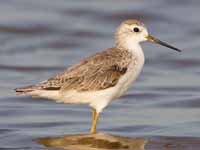
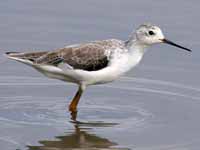

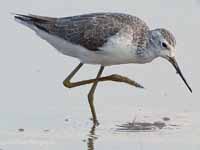
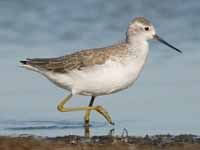
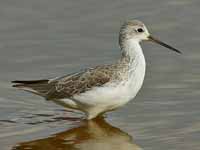
Sandpiper,_Solitary Tringa solitaria Found: The Americas
The Solitary Sandpiper is a dumpy wader with a dark green back, grayish head and breast and otherwise white underparts. It is a bird of fresh water, and is often found in restricted sites such as ditches. It does not gather in flocks. [Wikipedia].
Similar to: Green Sandpiper. Their ranges rarely overlap. In flight Solitary Sandpiper have a dark tail center; Green Sandpiper have a white rump in flight.
Similar to: Wood Sandpiper. Wood Sandpiper have a small dull white tail patch in flight; Solitary Sandpiper have a dark tail.
Image by: 1) Dick Daniels - New Hampshire 2) Felix_Uribe - Columbia 3) Dick - North Carolina 4) Tim Lindinbaum - Illinois Similar to: Green Sandpiper. Their ranges rarely overlap. In flight Solitary Sandpiper have a dark tail center; Green Sandpiper have a white rump in flight.
Similar to: Wood Sandpiper. Wood Sandpiper have a small dull white tail patch in flight; Solitary Sandpiper have a dark tail.
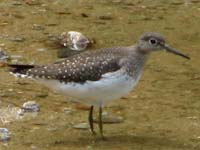
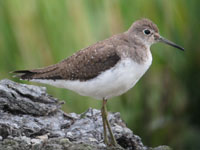
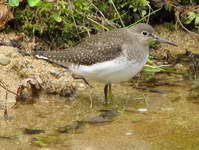
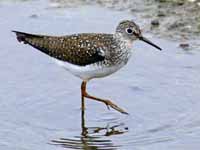
Sandpiper,_Wood Tringa glareola Found: North America (rarely), Europe, Asia, Africa, Australia
Wood Sandpiper have a relatively short, thin bill, a brown back, and yellowish legs.
Similar to: Green Sandpiper. Wood Sandpiper have a small dull white tail patch in flight; Green Sandpiper have a bright white tail in flight.
Similar to: Solitary Sandpiper. Wood Sandpiper have a small dull white tail patch in flight; Solitary Sandpiper have a dark tail.
Image by: 1) Alnus - Taoyuan County, Taiwan 2) JJ
Harrison - Thailand
3) Cristiano Crolle - near Novara, Italy 4) Dick Daniels - Tanzania 5, 6) Dick - Kenya 7) Jan_SvetlikSimilar to: Green Sandpiper. Wood Sandpiper have a small dull white tail patch in flight; Green Sandpiper have a bright white tail in flight.
Similar to: Solitary Sandpiper. Wood Sandpiper have a small dull white tail patch in flight; Solitary Sandpiper have a dark tail.
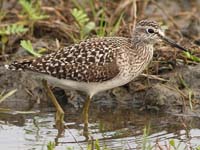
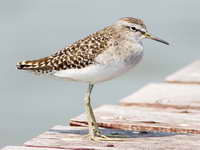
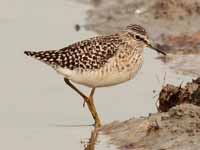
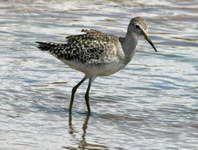


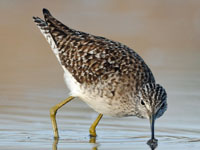
Tattler,_Gray-tailed Tringa brevipes Found: North America (rare), Europe, Asia, Australia
Gray-tailed Tattler have gray back and wings.
Similar to: Wandering Tattler. Their ranges rarely overlap. The best distinction between them is the call; Gray-tailed has a disyllabic whistle, and Wandering a rippling trill. [Wikipedia]
Image by: 1) JJ Harrison - Australia 2) honan4108 3) Alpsdake - Japan 4) Laurie_BoyleSimilar to: Wandering Tattler. Their ranges rarely overlap. The best distinction between them is the call; Gray-tailed has a disyllabic whistle, and Wandering a rippling trill. [Wikipedia]
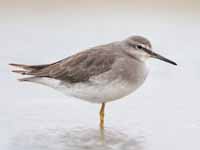
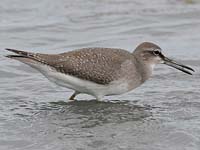
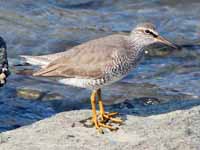
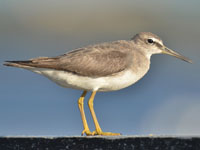
Tattler,_Wandering Tringa incana Found: The Americas, Asia, Australia
Wandering Tattler have gray back and wings; yellow legs; whitish belly.
Similar to: Gray-tailed Tattler. Their ranges rarely overlap. The best distinction between them is the call; Gray-tailed has a disyllabic whistle, and Wandering a rippling trill. [Wikipedia]
Image by: 1) Dick Daniels- Kauai, Hawaii 2, 3) Jason Crotty - California 4) Winnu 5) Anita_Gould - Sawaii 6) Aaron_Maizlish - CaliforniaSimilar to: Gray-tailed Tattler. Their ranges rarely overlap. The best distinction between them is the call; Gray-tailed has a disyllabic whistle, and Wandering a rippling trill. [Wikipedia]
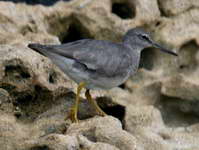
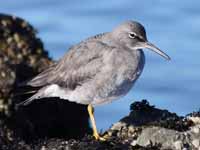
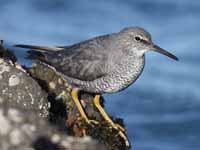
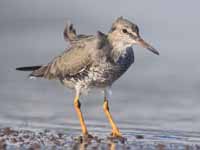
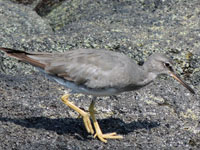
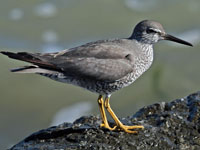
Willet, (Eastern) Tringa semipalmata semipalmata Found: East coast of The Americas
There are two distinct groups of willets - one on the east coast of the Americas and one on the west coast of the Americas. They may eventually be given independent species status.
Image by: 1, 3, 4, 5, 6, 7, 8, 9, 10)
Dick Daniels - North Carolina 2) Dick - Sanibel Island, Florida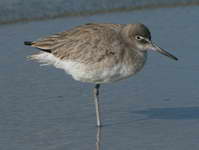
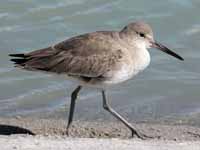
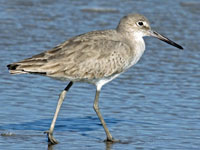
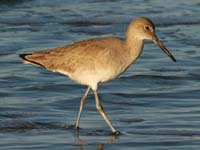
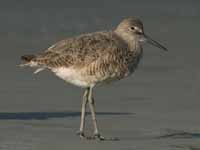
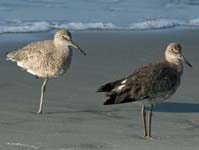
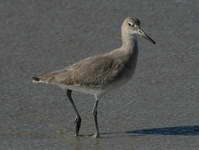

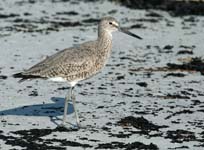
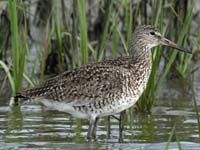
Willet (Western) Tringa semipalmata inornata Found: West coast of The Americas
There are two distinct groups of willets - one on the east coast of the Americas and one on the west coast of the Americas. They may eventually be given independent species status.
Image by: 1, 2, 3, 4) Dick Daniels - Half Moon Bay, California 5) Charlie Westerinen - tHuntington Beach, CA6) Alan D. Wilson - Huntington Beach, California
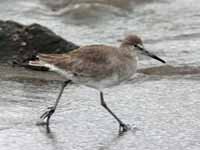
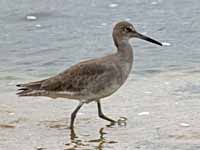
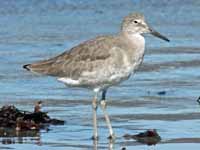
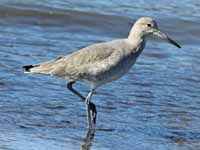
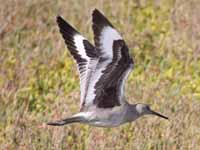
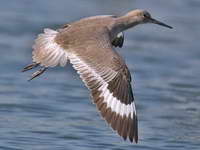
Yellowlegs, Greater Tringa melanoleuca Found: The Americas
The Greater Yellowlegs has long yellow legs, long thin dark lightly upturned bill, gray-brown upperparts, neck and breast streaked with dark brown, white belly and rump.
Similar to: Common Greenshank. Common Greenshank have green legs; Greater Yellowlegs have yellow legs.
Similar to Lesser Yellowlegs. The Greater Yellowlegs (approxiately Willet size) is considerably larger than the Lesser Yellowlegs (approximately Dowitcher size). Lesser always has a completely dark bill while nonbreeding Greater's bill becomes lighter near the base. Greater's bill is proportionately longer than the Lesser's bill. Greater's bill is concave on top surface, Lesser's is flat. Greater's call in flight is a 3 to 4 sequence and louder than the Lesser's 1 to 2 sequence.
Similar to: Spotted Redshank in nonbreeding season. Yellowlegs have yellow legs while Spotted Redshanks have red legs.
Image by: 1, 2, 9, 10, 11) Dick Daniels - North Carolina 3) Teddy Llovet - California 4) Elaine R. Wilson - California 5) Len Blumin - California 6) Dick - Chile 7) Don DeBold - California 8) Cláudio Timm - Brazil 12) Dick - New JerseySimilar to: Common Greenshank. Common Greenshank have green legs; Greater Yellowlegs have yellow legs.
Similar to Lesser Yellowlegs. The Greater Yellowlegs (approxiately Willet size) is considerably larger than the Lesser Yellowlegs (approximately Dowitcher size). Lesser always has a completely dark bill while nonbreeding Greater's bill becomes lighter near the base. Greater's bill is proportionately longer than the Lesser's bill. Greater's bill is concave on top surface, Lesser's is flat. Greater's call in flight is a 3 to 4 sequence and louder than the Lesser's 1 to 2 sequence.
Similar to: Spotted Redshank in nonbreeding season. Yellowlegs have yellow legs while Spotted Redshanks have red legs.
1) Greater Yellowlegs compared to Dowitchers 3) Greater and Lesser Yellowlegs
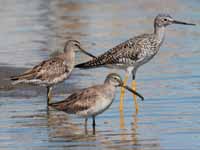
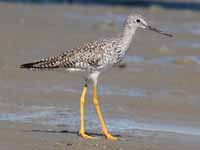
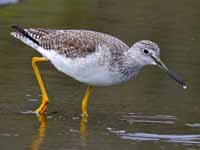
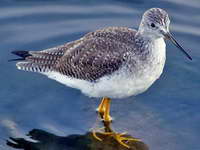
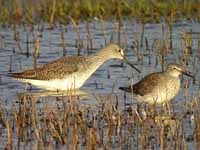
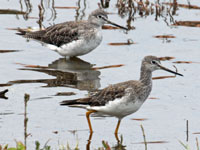
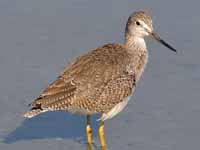
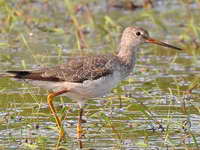
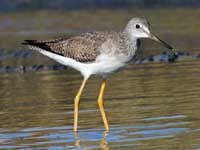
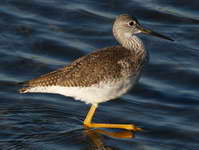
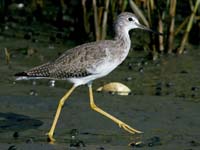
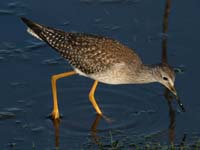
Yellowlegs, Lesser Tringa flavipes Found: The Americas
The Lesser Yellowlegs has long yellow legs, long thin dark lightly upturned bill, gray-brown upperparts, neck and breast streaked with dark brown, white belly and rump.
Similar to: Greater Yellowlegs. The Greater Yellowlegs (approxiately Willet size) is considerably larger than the Lesser Yellowlegs (approximately Dowitcher size). Lesser always has a completely dark bill while nonbreeding Greater's bill becomes lighter near the base. Greater's bill is proportionately longer than the Lesser's bill. Greater's bill is concave on top surface, Lesser's is flat. Greater's call in flight is a 3 to 4 sequence and louder than the Lesser's 1 to 2 sequence.
Similar to: Spotted Redshank in nonbreeding season. Yellowlegs have yellow legs while Spotted Redshanks have red legs.
Similar to: Upland Sandpiper. Upland Sandpiper are found around grassy environments unlike other similar birds that are usually found around water.
Image by: 1, 2) Wwcsig - New York 3, 4, 7) Dick Daniels - North Carolina 5, 6) Dick - McGee Island, MaineSimilar to: Greater Yellowlegs. The Greater Yellowlegs (approxiately Willet size) is considerably larger than the Lesser Yellowlegs (approximately Dowitcher size). Lesser always has a completely dark bill while nonbreeding Greater's bill becomes lighter near the base. Greater's bill is proportionately longer than the Lesser's bill. Greater's bill is concave on top surface, Lesser's is flat. Greater's call in flight is a 3 to 4 sequence and louder than the Lesser's 1 to 2 sequence.
Similar to: Spotted Redshank in nonbreeding season. Yellowlegs have yellow legs while Spotted Redshanks have red legs.
Similar to: Upland Sandpiper. Upland Sandpiper are found around grassy environments unlike other similar birds that are usually found around water.
1 - 4) Nonbreeding 5) Breeding
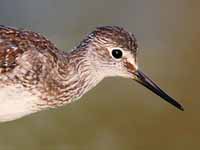
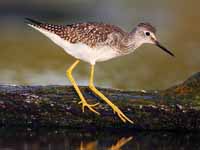
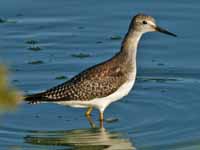
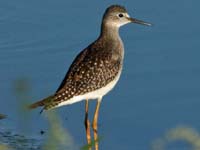
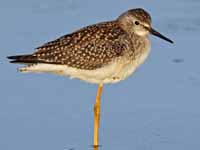


Genus Xenus - 1 species
Sandpiper,_Terek Xenus cinereus Found: Asia, Africa, Australasia
The Terek Sandpiper has a gray back, face, breast; white supercilium; whitish belly; black bill with yellow base; yellow feet. The bill is long and up-curved.
Image by: 1) Ainus - Taiwan 2) Alpsdake - Japan 3, 4) Imrun_Shah - Pakistan 5) Andi Li